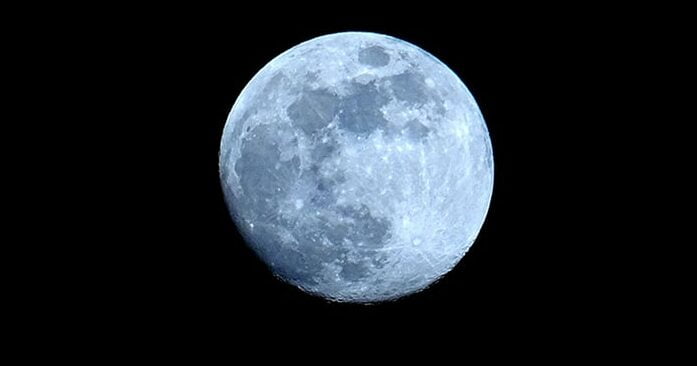Last week, American scientists released data indicating that the majority of astronauts who participated in manned flights to the Moon died from severe cardiovascular disease, while this cause of death is much less common among other astronauts. According to researchers, this is a result of the radiation exposure experienced in space. This news has sparked a mixed reaction and reignited the heated debate surrounding the credibility of NASA’s lunar program. In response to the editors of Life magazine, astronautics popularizer and spokesperson for “Dauria Aerospace” company, Vitaly Egorov, discussed the main misconceptions and stereotypes that often arise during discussions about humans on the Moon.
1- The pavilion was used to film the lunar landing
NASA had pavilions where they created a replica of the lunar module and simulated the lunar surface. They also had a test site that imitated lunar craters. However, all of this was done for training purposes, to familiarize the astronauts with the unique conditions and enable them to work more efficiently. Such training is a standard part of any mission. Similarly, Soviet lunar rover drivers trained at a proving ground in Crimea and on the volcanoes of Kamchatka, not to fake Moon images, but to prepare for what awaited them on the actual lunar surface. The images officially recognized as lunar images were indeed captured on the Moon, and their correspondence with satellite images of the lunar surface can be analyzed.
Several Russian astronauts and space experts, who have no doubts about the credibility of the American Moon missions, still hold on to the belief that they were “filmed in a studio.” Our astronauts argue: “They did go to the Moon, but certain aspects of the moon landing could have been filmed on Earth and shown for the sake of clarity – to demonstrate what it was like there. In my view, this stance is partly due to the pressure our experts face in having to explain any disputed moments in the photographs and videos, such as the flag appearing to wave or the absence of stars in the sky.”
2. The flag is fluttering, but there are no stars in the sky
An argument commonly used in debates to support a conspiracy theory. However, it is important to distinguish between actually flying to the moon and filming the moon landing – one does not necessarily negate the other. Additionally, it is crucial to have a better understanding of the surface conditions and to carefully analyze videos and photos. As for the flag, it’s quite simple – the astronaut is merely moving it with their hand. If you watch a longer recording, rather than just a few seconds of footage of the flag installation (which can now be found on video sharing platforms like YouTube), you can observe a direct correlation between the astronaut’s movements and the flag’s movement. When the astronaut holds onto the flag, the wind causes it to flutter; when they let go, the wind subsides. This pattern repeats several times.
The absence of stars in the Moon photos can be explained by the fact that the astronauts landed during the daytime. Despite the black sky on the Moon, the cameras were set up to capture images in daylight conditions because the brightness of the Sun on the Moon is even greater than on Earth. Similarly, if you examine images taken on the International Space Station from the sunny side of the Earth, you won’t see any stars in the black sky either.
While this myth does have some basis in reality, it is not entirely accurate. All of the photos and videos captured by the Apollo 11 mission’s cameras on the Moon’s surface have indeed been preserved and made available to the public. However, the live television broadcast footage from the Moon to NASA’s receiving station, which was then distributed to various television studios, has been re-recorded. Because the TV broadcasts were witnessed by millions of viewers and copies of the recordings were already stored at the television studios, NASA did not place a high priority on preserving the magnetic reels containing the broadcasts in their archives. As a result, when the need arose in the 1980s, these reels were easily re-recorded.
In the 2000s, it was discovered that the recordings from TV studios suffered a significant loss of quality, while NASA stations received a much better signal. Despite efforts to locate the original broadcast sources, they were unable to find them. To enhance the quality of the recordings, experts from Hollywood were enlisted. As a result, Hollywood officially collaborated with NASA in producing the records of the lunar landing, a fact that is openly acknowledged on the NASA website. However, this does not undermine the undeniable reality of the initial landing and the five subsequent ones, for which the recordings have been preserved.
4. The Saturn-5 rocket vanished without any evidence after the lunar program was completed
A legend has emerged due to the impossibility of reproducing this rocket today, as all the individuals and organizations involved in its creation have either disappeared or shifted their focus. Furthermore, the significant disparity in capabilities between the 1960s rocket, which could launch 140 tons into low-Earth orbit, and contemporary rockets with a record of only 28 tons is truly astounding.
The Saturn-5 rocket itself has not vanished; NASA possesses two examples of the rocket that are housed in museums at the Johnson Space Center (Houston) and Kennedy Space Center (Cape Canaveral). Additionally, there are numerous F1 engines that delivered the rocket’s impressive capabilities. Currently, NASA has a small team dedicated to reverse-engineering: using the surviving samples, they are developing a new version of the engine utilizing modern technology. However, this project is not of utmost importance, as NASA possesses engines that surpass the F1 in several aspects.
Similarly, the Soviet rockets H1 and Energia have “disappeared”. If Russia considers constructing a super-heavy rocket, they are discussing starting almost from scratch, rather than revisiting the Soviet legacy.
5. At present, the United States lacks its own rocket engines, implying that it lacked them in the past as well
There is a misconception among some Russians that the successful sale of Russian RD-180 and RD-181 engines to the United States implies that America has lost the capability, if not the ability, to manufacture rocket engines.
However, it is important to clarify this misunderstanding with two straightforward facts: the Delta IV Heavy, which is currently the most powerful rocket, is American-made and is equipped with American RS-68 engines.
The engines currently used by the United States are oxygen-hydrogen engines that have been passed down from the Space Shuttle program. The main issue with these engines is their high cost, which is why it is more financially advantageous for the US to purchase Russian engines.
Out of all the rocket engines available today, the most powerful ones are the solid-fuel SRB engines. These engines, which are even more powerful than the F1 and RD-171 engines, were also derived from the Space Shuttle program. The SRBs are currently being utilized in the new SLS super-heavy rocket, which is designed to launch payloads weighing up to 70 tons into low-Earth orbit. The adoption of SRBs is one of the reasons why NASA decided not to revive the F1 engine.
When it comes to tasks such as satellite launches or supplying the International Space Station, the United States relies on a combination of Russian engines and SpaceX’s Merlin engines.
6. A rocket and a spaceport were necessary for leaving the Moon, but they were absent
Actually, they were present. The lunar landing module served not only as a means of gently landing on the Moon’s surface, but also as a device for taking off. The upper part of the module functioned as both a cabin for the astronauts and a rocket for launching, while the lower part of the landing module served as a spaceport.
To leave the Moon’s surface and enter lunar orbit, significantly less energy is required compared to launching from Earth. This is due to the lower gravity, absence of atmospheric resistance, and the lower mass of payloads, making it possible to forgo the use of large rockets.
7. NASA has either misplaced or carefully concealed all of the lunar soil
Throughout the six missions to the moon, the astronauts were able to gather and transport 382 kilograms of lunar samples. The majority of these samples are currently stored at the Lunar Sample Laboratory in Houston. However, approximately 300 kilograms of these samples are currently inaccessible for research purposes. They are being stored in a nitrogen environment to prevent any changes or deterioration caused by Earth’s conditions, specifically atmospheric oxygen. On the other hand, around 80 kilograms of samples are available for scientific examination by researchers from all over the world, including Russia. If you are interested in finding scientific publications that compare lunar meteorites, samples from Soviet stations, and samples brought back by Apollo astronauts, they can be found.
Although a small percentage of the lunar rocks and dust delivered under the Apollo program were unfortunately stolen or lost in museums and institutes, the overall amount remains largely intact.
For individuals intrigued by this subject, I would suggest checking out a photo report created by a young Russian astronaut named Sergey Kud-Sverchkov. He recently visited the Lunar Sample Laboratory tours and shared the captivating photos on his blog.
8. The Impact of Space Radiation on Astronauts
The press frequently discusses the possibility of a manned mission to Mars, and one of the major challenges that is often mentioned is the issue of cosmic radiation. This raises the question of how astronauts were able to safely travel to the Moon if radiation is indeed so hazardous.
In order to comprehend the disparity in flight conditions, it is important to bear in mind that a journey to Mars spans a year and a half, whereas a trip to the Moon as part of the Apollo program lasts less than two weeks. Upon scrutinizing the findings of research on the impact of cosmic radiation during a voyage to Mars, one would discover that over the course of 500 days in space, an astronaut would be exposed to a dosage approximately one and a half times higher than the permissible level. For astronauts, this level equates to a 3 percent increase in the risk of developing cancer, whereas a journey to Mars already poses a 5 percent risk. To provide a point of comparison, smokers expose themselves to a 20 percent risk of developing cancer.
It is important to remember the Soviet and later Russian experiments on space radiation. Currently, the experiments “Phantom” and “Matryoshka” are being conducted on the International Space Station (ISS), and the “Phantom” has even been sent to the Moon on the “Probe-7” mission to assess the impact of cosmic particles on human health. Overall, the findings are reassuring: as long as there are no solar flares, it is deemed safe for space travel. If it were not possible, Roscosmos would likely not be investing in a lunar program for the late 2020s or making plans for a lunar base.
9. The Soviet Union Became Part of the Plot
Immediately after the U.S. successfully landed on the moon, Soviet political leaders were quick to extend their congratulations. Even today, Russian cosmonauts and scientists maintain their belief in the authenticity of the moon landing. However, conspiracy theorists face a challenge in reconciling these facts with their own beliefs. To address this, the notion that the USSR was also involved in the conspiracy was conceived. Advocates of the conspiracy theory often point to historical events during the period of détente between our countries, such as arms limitation agreements, trade cooperation, and the Soyuz-Apollo program, to support their claims.
Despite the fact that the Soviet Union has ceased to exist for 25 years, there is no concrete proof of any Soviet involvement in the Lunar Conspiracy. Additionally, there is not one piece of testimony from people who lived during that time that supports the existence of such a conspiracy. However, currently, there appears to be no obstacle in revealing the truth about the American involvement.
10. The presence of astronauts on the Moon remains unverified, and access to the “landing site” is restricted for observation and research
Even the most advanced telescopes on Earth are unable to detect the footprints left by the lunar landings. These telescopes can only capture surface details as small as 80-100 meters, which is much larger than the size of the lunar module. The only way to observe the lunar modules and astronaut tracks is by deploying a satellite or a lunar rover to the Moon’s surface.
Over the past 15 years, various countries, including Europe, India, Japan, China, and the United States, have sent satellites to the Moon. However, it is NASA’s LRO satellite that has managed to capture relatively high-quality images. With a detail resolution of up to 30 centimeters, these images allow for the observation of lunar modules, scientific equipment, astronaut paths, and traces left by lunar rovers.
In 2007, the Google Lunar X PRIZE competition was introduced to encourage the development of a privately-funded lunar rover capable of reaching the Moon and traversing a specific distance. The winning team would be awarded a prize of up to $30 million. Additionally, there is a $2 million Heritage Prize for the team that is able to capture photographs of one of the Apollo lunar modules or “Moonwalkers.” However, NASA has expressed concern about potential damage to historic landing sites from an influx of private robots and has cautioned against getting too close to these areas to preserve the astronaut footprints and protect these important historical landmarks. Currently, only one team participating in the competition has announced plans to explore the Apollo 17 moon landing site.

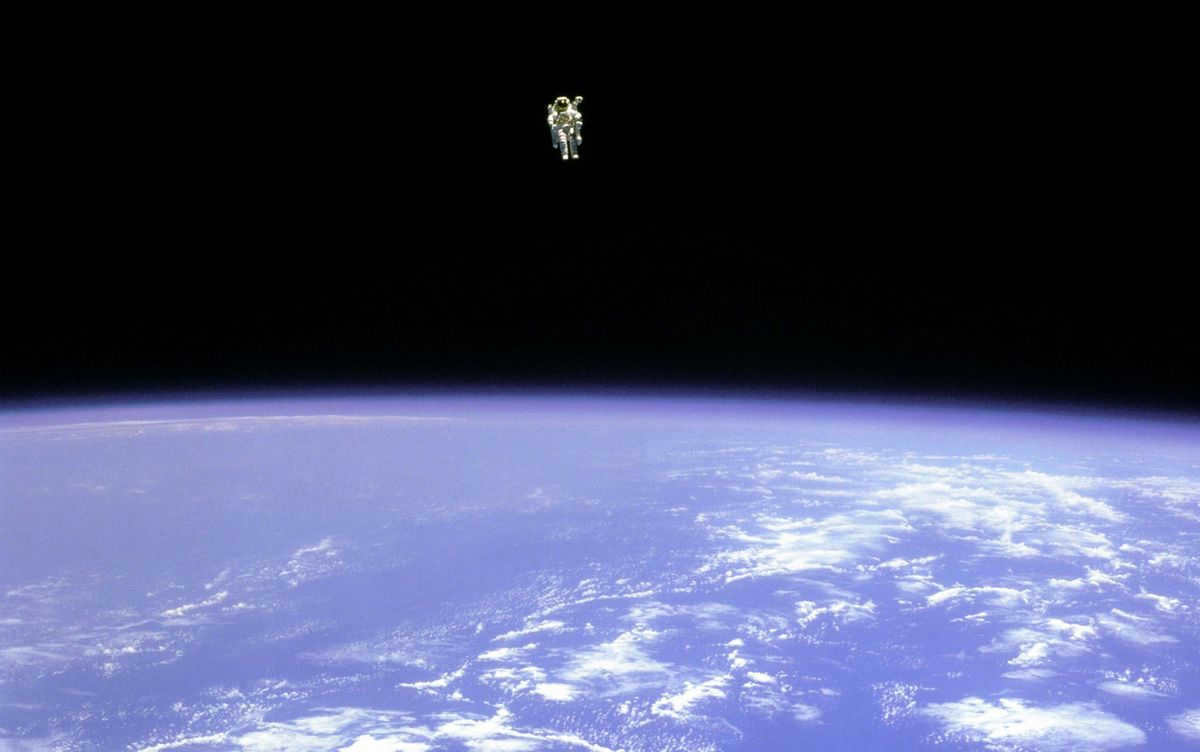
Outer space is often described as a vast and mysterious void that stretches beyond our Earth’s atmosphere. During the day, when we gaze up at the sky, the vibrant blue color is a result of the sunlight being reflected by the air molecules, creating a dazzling spectacle. It’s as if millions of tiny mirrors are scattered across the atmosphere, bouncing the light back to our eyes.
However, when we venture to the Moon, we’re met with a completely different sight. Without an atmosphere to act as a mirror, the sky appears black and the stars shine brightly, even in the presence of the Sun. This phenomenon is not limited to the Moon, but extends to the vast expanse of outer space itself. In this cosmic void, there are so few molecules that the sunlight cannot be reflected back to the observer, resulting in an intimidating black abyss.
Why is space black even though stars emit light?
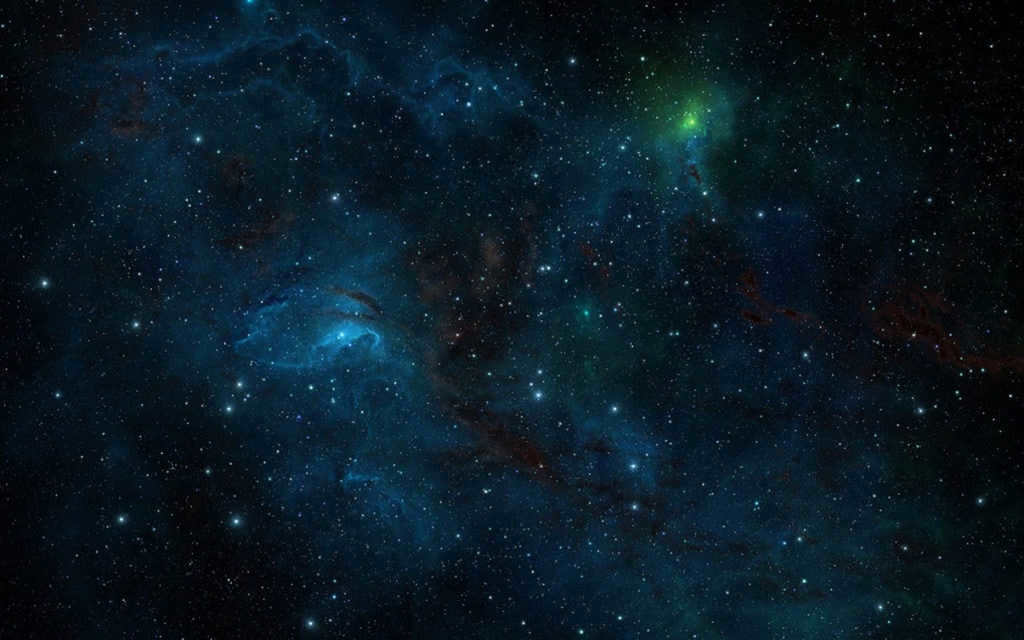
The enigma of the darkness in space remains an enduring enigma that has sparked countless debates among scientists for centuries. What is the reason behind the absence of a blinding collective luminosity from the stars that populate our vast universe? Why does the night sky appear black? In the 16th century, astronomer Thomas Diggs found himself captivated by these inquiries. Diggs firmly believed that the universe knows no boundaries or limits, stretching infinitely in all directions, existing since time immemorial and destined to persist eternally, housing an incalculable multitude of stars.
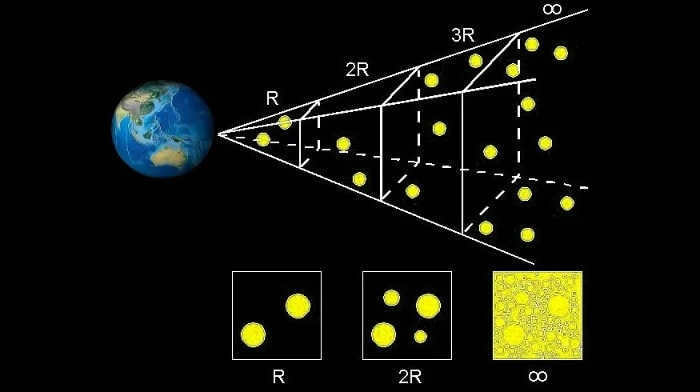
“If the sky is filled with an endless array of stars,” he contemplated, “then there must be stars in every direction we turn. Adorned with faraway suns, the sky would bedazzle us with its radiant glow. However, it does not.” Diggs never managed to unravel this enigma. Wilhelm Olbers, a 19th-century German astronomer, similarly pondered this question for countless years. The predicament of why the night sky appears dark became known as ‘Olbers’ paradox’.”
Olbers proposed various solutions to the riddle, only to later discard them and conclude that the culprit was dust scattered throughout the air. Did he believe that the light emitted by distant stars is absorbed by this dust, rendering it invisible to our eyes? This explanation implied that an infinite number of stars were concealed behind a shroud of dust.
The Remote Nature of Stars
Following Olbers’ discovery, it was determined that the stars have the ability to emit energy that can warm up any dust particles, causing them to glow. This led to the conclusion that the nighttime sky appeared to be illuminated by this glowing dust. This finding initially seemed to resolve the issue, but it presented a paradoxical situation. Subsequently, scientists proposed alternative theoretical explanations. One such explanation suggests that distant stars emit fainter light compared to those that are closer, making the light from distant stars either very dim or completely invisible. However, this explanation is deemed unsatisfactory since, given the countless number of stars, there should still be enough light to illuminate the sky. Consequently, the sky should remain bright.
The Quantity of Stars
However, every evening, the sky remains persistently devoid of light. This contradicts the theory. But why is this the case? Diggs, Olbers, and others hypothesized that there are innumerable stars in an infinitely vast universe. Unfortunately, their hypothesis was incorrect. Astronomer Edward Harrison from the University of Massachusetts at Amherst has published a book titled “Night Darkness: The Mystery of the Universe.” In it, he asserts that the quantity of stars is insufficient to illuminate the night sky. The reason the night sky is not bright is that both the stars and the universe have finite limits.
Fascinating fact: Even during the day, the sky on the Moon appears black because the Moon lacks an atmosphere to reflect and scatter sunlight.

Using the most advanced telescopes, we can now observe the point at which the stars come to a halt. The light from distant stars takes millions of years to reach us, so when we gaze up at the sky, we are actually peering into the distant past. Thanks to the incredible power of these telescopes, we are able to witness light that embarked on its journey to us approximately 10 billion years ago.
Why is outer space black? – a fascinating video
If you come across any mistakes, kindly mark the text and hit Ctrl+Enter.
The Moon is a cosmic object that revolves around the Earth in the vast expanse of space. It is a natural satellite and the nearest one to the Sun compared to the satellites of other planets.
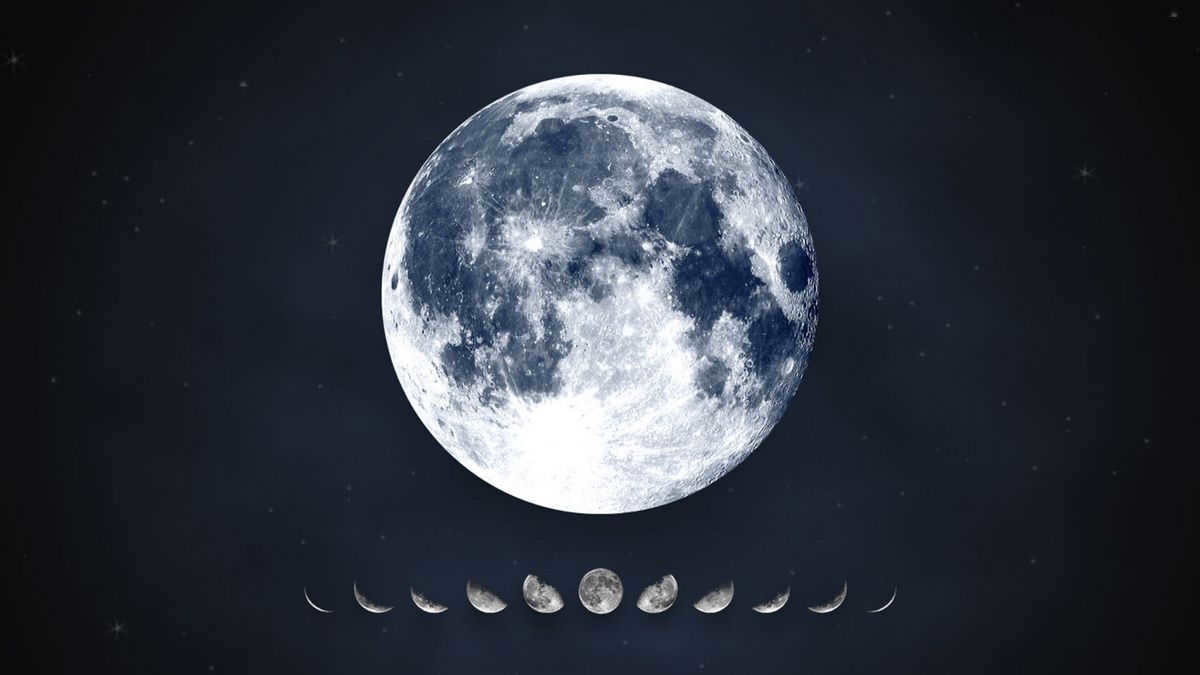
Information and features of the Moon
The visible sidereal magnitude of the full Moon in the Earth’s atmosphere is -12.71m. The Moon is the second most luminous entity in the Earth’s atmosphere, following the Sun.
The distance between the Earth and the Moon changes between 363,104 kilometers and 405,696 kilometers. On average, the centers of the Earth and the Moon are about 384,467 km apart (0.00257 astronomical units, approximately 30 Earth diameters). The Moon follows an elliptical path around the Earth. The orbit is noticeably elliptical, with an eccentricity of 0.0549. This causes the apparent size of the Moon to continuously vary between 29 and 32 angular minutes. The Moon completes one orbit around the Earth in a period of 27 days, 7 hours, 43 minutes, and 11.5 seconds. At its closest point to Earth, called perigee, the Moon is about 356,400 to 370,400 km away, and at its farthest point, called apogee, it is about 404,000 to 406,700 km away. The orbit of the Moon is inclined at an angle of 5.145 degrees to the plane of the Earth’s orbit around the Sun. The average speed of the Moon along its orbit is approximately 1.023 km/s.
The Moon is about 1/81.3 the mass of the Earth. If we assume the Earth has a mass of 5.977 x 10^24 kg, then the Moon’s mass is approximately 7.35 x 10^22 kg. Based on the Moon’s size and mass, we can calculate its average density to be 3.34 g/cm^3, which is significantly lower than the Earth’s average density of 5.52 g/cm^3.
The acceleration of free fall on the Moon is 1.62 m/s^2, compared to 9.81 m/s^2 on Earth. This means that the force of gravity on the Moon is about six times weaker than on Earth, resulting in a person feeling lighter on the Moon’s surface. The second cosmic velocity on the Moon is 2.38 km/s, while on Earth it is 11.19 km/s.
The majority of the Moon always has one side facing the Earth because of synchronized rotation, also known as tidal capture. This occurs when the time it takes for the Moon to rotate on its axis matches the time it takes for it to orbit around the Earth. As a result, the Moon consistently presents the same side to the Earth because it completes one rotation on its axis in the same duration as its orbit around the Earth.
The movement of the Moon around the Earth can be understood as a combination of different motions:
- It orbits around the Earth in an elliptical path, known as an orbit, with a duration of 27.32166 days. This is referred to as the sidereal month, which is measured in relation to the stars.
- The plane of the lunar orbit undergoes a rotation, causing its nodes (the points where the orbit intersects with the ecliptic) to shift westward. This complete revolution occurs every 18.6 years and is known as precession.
- The major axis of the lunar orbit, also known as the apsidal line, undergoes a rotation in the opposite direction to the movement of the nodes. This rotation occurs every 8.8 years, causing the longitude of the perigee to increase.
- The inclination of the lunar orbit with respect to the ecliptic periodically changes from 4°59′ to 5°19′.
- The size of the lunar orbit also periodically changes. The perigee distance ranges from 356.41 to 369.96 thousand km, while the apogee distance ranges from 404.18 to 406.74 thousand km.
- The Moon gradually moves away from the Earth due to tidal acceleration, resulting in a slow unwinding spiral in its orbit. This movement causes the Moon to move away from the Earth by 38 mm per year.
The Moon is the sole celestial body beyond Earth that has been explored by humans.
Unlike Earth, the Moon lacks a magnetic field.
Table: Physical attributes of the Moon.
| Mass (10 24 kg) | 0.07346 | 5.9724 | 0.0123 |
| Volume (10 10 km 3 ) | 2.1968 | 108.321 | 0.0203 |
| Equatorial radius (km) | 1738.1 | 6378.1 | 0.2725 |
| Polar radius (km) | 1736.0 | 6356.8 | 0.2731 |
| Volumetric mean radius (km) | 1737.4 | 6371.0 | 0.2727 |
| Ellipticity | 0.0012 | 0.00335 | 0.36 |
| Average density (kg /m 3 ) | 3344 | 5514 | 0.606 |
| Surface gravity (m /s 2 ) | 1.62 | 9.80 | 0.165 |
| Surface acceleration (m /s 2 ) | 1.62 | 9.78 | 0.166 |
| Escape velocity (km /s) | 2.38 | 11.2 | 0.213 |
| GM (x 10 6 km 3 /s 2 ) | 0.00490 | 0.39860 | 0.0123 |
| Bond’s albedo | 0.11 | 0.306 | 0.360 |
| Geometric albedo | 0.12 | 0.434 | 0.28 |
| V-band magnitude V (1.0) | -0.08 | -3.99 | – |
| Solar irradiance (W/m 2 ) | 1361.0 | +1.000 | |
| Blackbody temperature (K) | 270.4 | 254.0 | 1.065 |
| Topographic range (km) | 13 | 20 | 0.650 |
| Moment of inertia (I / MR 2 ) | 0.394 | 0.3308 | 1.191 |
| J2 (х 10 -6 ) | 202.7 | 1082.63 | 0.187 |
Moon Phases
The Moon doesn’t emit its own light, it simply reflects sunlight. Only the portion of the lunar surface that is illuminated by the Sun can be seen from Earth.
Moon Phases – The regular change in the appearance of the illuminated part of the Moon as seen from Earth. The length of time it takes for the Moon to complete one cycle of phases (known as a synodic month) varies due to the elliptical shape of its orbit, ranging from 29.25 to 29.83 Earth solar days. The average synodic month is 29.5305882 days (29 days 12 hours 44 minutes 2.82 seconds).
When the Moon is illuminated from the side, it takes on a crescent shape due to its spherical body. The Sun’s illumination of the visible side of the Moon varies depending on its orbital position. Regardless of whether the Sun is hidden behind the horizon, the illuminated side of the Moon always faces towards it. This results in a range of illumination for this side, from 0% during a new moon to 100% during a full moon. During the phases of the Moon that are close to a new moon, such as the beginning of the first quarter and the end of the last quarter, a very thin crescent shape can be observed. This is known as the “ash light of the Moon,” which is a faint reflection of the Sun’s rays off the Earth.
When the Moon and the Sun are closest to each other, it marks the beginning of a new moon phase cycle.
The Moon goes through various stages of illumination, including:
- New Moon – a phase when the Moon is not visible;
- Youthful Moon – the first sighting of the Moon in the sky after the new moon, appearing as a slim crescent;
- First Quarter – a phase when half of the Moon is illuminated;
- Waxing Moon;
- Full Moon – a phase when the entire Moon is illuminated;
- Waning Moon;
- Last Quarter – a phase when half of the Moon is illuminated again;
- Old Moon
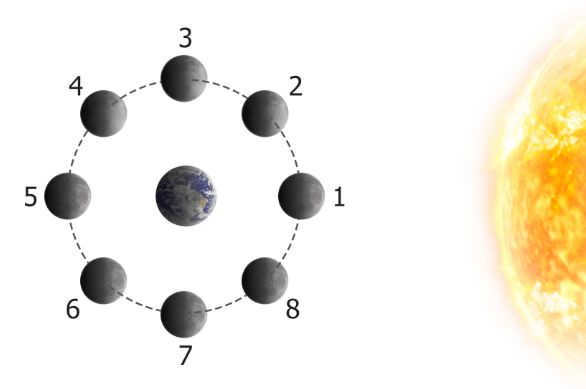
Figure 1. Movement of the Moon. The changing phases of the Moon.
Typically, there is one full moon for each month on the calendar. However, due to the slightly faster rate at which the phases of the moon change (more than 12 times a year), there are occasions when there are two full moons in a single month, known as blue moons.
Lunar and solar eclipse
A lunar eclipse happens when the Moon enters the shadow cone cast by the Earth. At a distance of 363,000 km (the Moon’s minimum distance from Earth), the diameter of the Earth’s shadow spot is approximately 2.5 times the diameter of the Moon, which means the Moon can be completely shadowed.
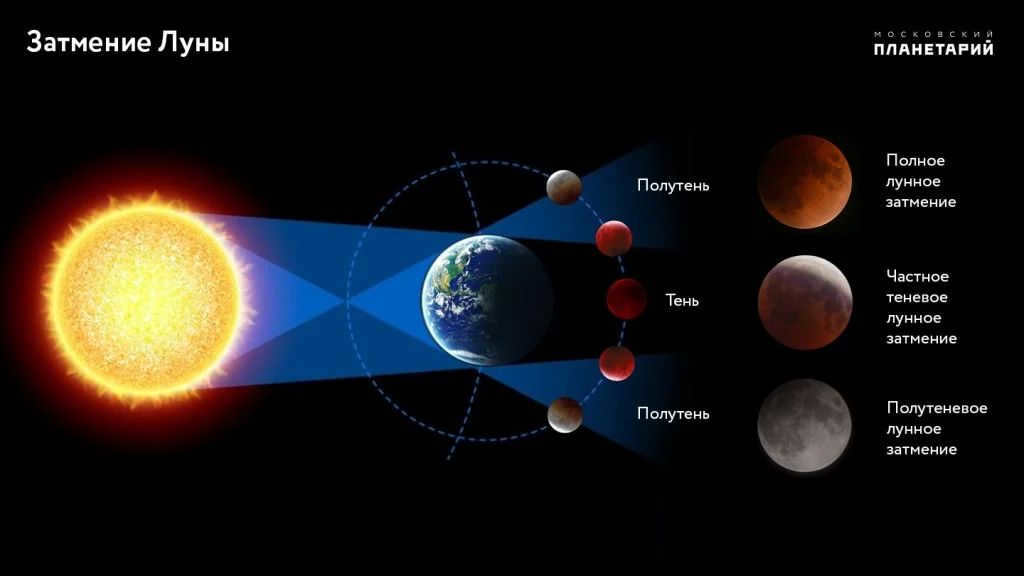
A lunar eclipse happens when the Earth is positioned between the Sun and the Moon, causing the Earth’s shadow to fall on the Moon. As a result, the Moon appears darkened or reddish in color during a lunar eclipse. It is important to note that a lunar eclipse can only occur during a full moon phase.

Solar Eclipse Diagram
Decades of observation and documentation have revealed that lunar and solar eclipses follow a pattern known as saros, which spans approximately 6585.3 days or 18 years, 11 days, and nearly 8 hours. Within one saros, there are typically 28 to 29 lunar eclipses and 41 to 43 solar eclipses.
Atmosphere and Temperature of the Moon
The Moon lacks a substantial atmosphere. The lunar atmosphere consists of an extremely thin gas envelope around the Moon, which is about ten trillion times less dense (with a surface pressure of approximately 10 nPa) than the Earth’s atmosphere. It primarily consists of hydrogen, helium, neon, and argon.
The sources of the lunar atmosphere are both internal processes, such as the release of gases from the Moon’s crust and volcanic activity, as well as external factors like micrometeorite impacts and the solar wind. Due to its weak gravity, the Moon is unable to retain all the gases released on its surface, causing most of them to disperse into space.
The Moon’s surface experiences a significant temperature variation due to the rarefaction of the atmosphere, ranging from -173 °C during the night to +127 °C at sunrise, depending on the level of illumination. However, the temperature of rocks located 1 meter beneath the surface remains constant at -35 °C.
The Structure and Characteristics of the Moon
The Moon is composed of various layers, including the crust, upper mantle, middle mantle, lower mantle, and core. The crust of the Moon is approximately 68 kilometers thick on average, with variations ranging from no crust in the lunar Sea of Crises to 107 kilometers in the northern region of Korolev Crater on the far side of the Moon. The lunar mantle consists of multiple layers, including the upper mantle (which extends up to 200-300 kilometers), the middle mantle (which extends up to 500-600 kilometers), and the lower mantle (which extends up to 800-900 kilometers). The inner core of the Moon has a shell with a radius of about 240 kilometers, while the outer core is a liquid with a radius of approximately 300-400 kilometers.
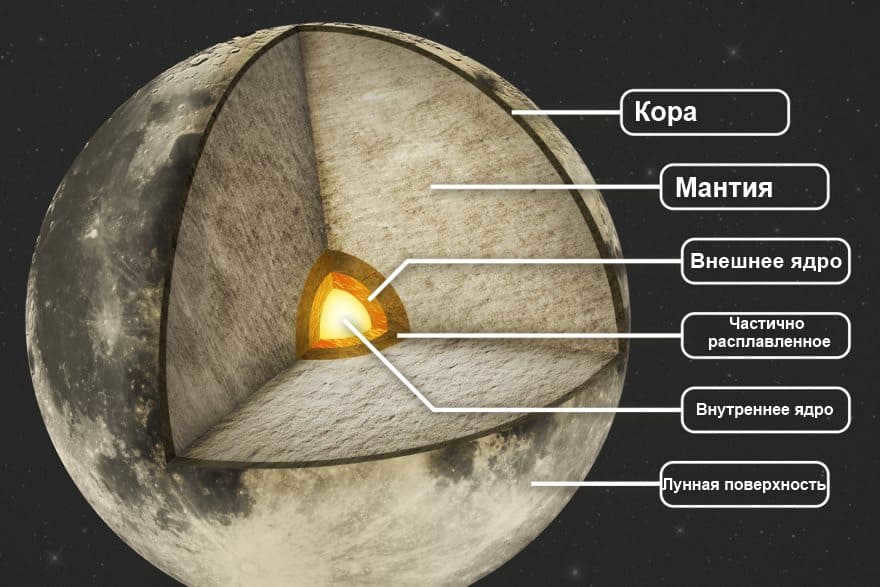
The Moon’s surface is coated with regolith, a combination of fine dust and rocky fragments resulting from meteorite impacts on the lunar surface. The explosive processes that occur during meteorite bombardment contribute to the loosening and mixing of the soil, while also fusing and compacting the soil particles.
The lunar regolith contains a significant amount of oxygen, which is found in oxides, with silicon dioxide being the most abundant at 42.8%.
Table: Composition of lunar regolith in percentage
The Moon’s surface can be categorized into two distinct types:
- Extremely ancient mountainous regions (known as lunar continents).
- Comparatively smooth and younger lunar seas.
Lunar “seas,” comprising approximately 16% of the Moon’s overall surface, are enormous craters formed by collisions with celestial bodies that were subsequently filled with molten lava. Due to the influence of gravitational forces during the Moon’s formation, its “seas,” beneath which denser and heavier rocks have been discovered by lunar probes, are predominantly concentrated on the side facing Earth.
Most of the craters on the Earth-facing side of the Moon have been named after notable figures in the history of science, such as Tycho Brahe, Copernicus, and Ptolemy. On the other hand, the terrain features on the far side of the Moon bear more contemporary names like Apollo, Gagarin, and Korolev.
There is a massive depression on the far side of the Moon known as the South Pole-Eitken Basin. It measures 2250 km in diameter and is 12 km deep, making it the largest basin in the entire solar system. This basin was formed as a result of a collision. On the visible side of the Moon, there is a fascinating feature called the East Sea, which is a multi-ring crater that can be observed from Earth.
In addition to these major topographical features, there are also smaller details on the lunar surface such as domes, ridges, and furrows. These narrow, sinuous valley-like depressions add to the overall relief of the Moon.
One interesting discovery is the presence of water on the Moon. Scientists have found at least 600 million tons of water in the North Pole region, with most of it existing as ice blocks at the bottom of lunar craters. Water has been detected in over 40 craters, ranging in size from 2 to 15 kilometers in diameter.
Moonquakes, which are seismic surface vibrations, are another phenomenon on the Moon. These moonquakes can be classified into four different groups.
- Tidal occurrences, which happen twice a month, are prompted by the gravitational forces of both the Sun and the Earth;
- Tectonic activities are irregular and are caused by movements within the Moon’s crust;
- Meteoric phenomena are brought about by the impact of falling meteorites;
- Thermal events are a result of the rapid heating of the lunar surface during sunrise.
50 fascinating pieces of information about the Moon
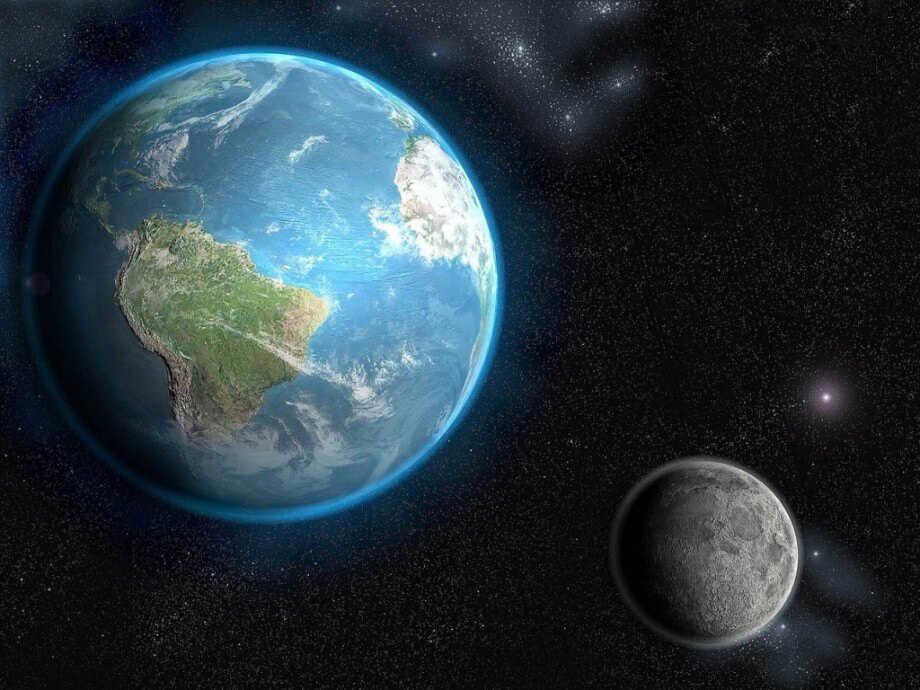
- The Moon is a unique planet that serves as a satellite to the Earth. It is positioned approximately 384,403 kilometers away from our planet.
- Among the celestial bodies in the Solar System, the Moon is the second most luminous object, following the Sun itself.
- Unlike Mercury and Venus, which lack satellites, the Moon is the nearest planetary satellite to the Sun.
- According to scientific theories, the Moon came into existence through a colossal collision. Around 4.5 billion years ago, a massive object comparable in size to Mars collided with Earth. This impact was so immense that it propelled large portions of Earth’s rocks into space. The ejected debris then accumulated in Earth’s orbit and eventually formed the Moon. Soil analyses indicate that the Moon is composed of less dense materials with minimal iron content.
- The term Luna is derived from another Slavic term, “Luna”, which means “Radiant”.
- The Moon’s entire surface is covered in craters because, unlike Earth, it lacks its own atmosphere to shield it from celestial bodies like meteorites. When a meteorite enters Earth’s atmosphere, the friction with the air causes it to ignite and typically burn up before reaching the ground. On the Moon, anything that falls onto its surface leaves behind large marks in the form of craters.
- The craters on the Moon’s surface were created by meteorites approximately 4.1 to 3.8 billion years ago. They remain visible today simply because the Moon is not as geologically active as Earth.
- Hertzsprung, a lunar crater with a diameter of 591 kilometers, stands out among the other craters on the Moon. However, it is located on the dark side of the Moon, making it invisible from Earth. On the visible side of the Moon, the largest crater is Bayi, which has a diameter of 287 kilometers.
- Aitken, the largest crater on the Moon, measures approximately 2000 kilometers in diameter. Remarkably, it is also the largest crater in the entire solar system.
- Initially, the craters on the Moon were named after renowned scientists, artists, and explorers. However, later on, they were also named after American astronauts and Russian cosmonauts.
- The Moon is not perfectly spherical; rather, it has an egg-like shape due to the influence of Earth’s gravity. Moreover, its center of mass is not situated at the exact center of the celestial body but approximately two kilometers away.
- Currently, there is a growing number of individuals attempting to profit from the Moon. They are marketing parcels of lunar land and providing buyers with a certificate that claims they have the rights to settle hundreds of acres of space on the Moon. However, it is important to note that even if colonization of the Moon were to occur, these certificates would hold no legal weight and would be deemed invalid.
- The initial sale of lunar plots was initiated by The Lunar Embassy, an American company established by Dennis Hope, who sold them for $20 per acre (approximately 4046 square meters). Hope, after carefully examining the United Nations Outer Space Convention, determined that there were no provisions within it that explicitly prohibited private ownership of celestial bodies. As a result, he declared himself the rightful owner of the Moon, Mars, Mercury, Io, Venus, and began trading these “star” plots.
- The official name of Earth’s natural satellite is Luna. When our celestial body was initially named Moon, astronomers were unaware of the existence of other planets in our solar system that also had natural satellite moons. Now, to differentiate between the various moons in our system, our specific satellite is referred to as the Moon, with a capital “L”, while the moons of other planets are referred to with a lowercase letter.
- The Moon ranks as the fifth largest satellite in the solar system. However, the largest moon in the entire solar system is Ganymede, which is a satellite of Jupiter and has a diameter of 5262 kilometers. Following Ganymede, we have Titan, a moon of Saturn, and then Callisto and Io, both moons of Jupiter. Finally, we have our very own Moon, with an average diameter of 3475 kilometers.
- In order for the Moon to shine as brightly at night as it does during the day, we would require approximately three hundred thousand moons. Furthermore, for there to be a total lunar eclipse, we would need precisely 206,264 moons to be in the phase of the full moon.
- There is a possibility that Earth possesses other natural satellites. Asteroid Cruithne is in a state of orbital resonance with Earth and completes a full revolution around our planet every 770 years.
- The gravitational force on the surface of this satellite is only 17% of that on Earth. Let’s say your weight is 100 kilograms. If you were standing on the surface of the moon, you would only weigh 17 kg. You would also be able to walk six times the distance and carry six times the weight compared to Earth. With your own muscle power alone, you would even be capable of making short flights over the moon’s surface.
- Due to the low gravity on Earth’s satellite, a fine and hard lunar dust with a scent resembling gunpowder can spread everywhere. This dust has caused astronauts to experience symptoms similar to hay fever. It can penetrate spacesuits and shoes, significantly deteriorating their quality.
- Solar eclipses occur frequently in our lives, but witnessing a lunar eclipse in your vicinity is an almost surreal experience. This rare opportunity arises only once every few hundred years.
- The Moon possesses an exosphere, an atmosphere composed of helium, neon, and argon.
- When observed from Earth, the Moon appears to be the same size as the Sun. However, the Sun is significantly larger than the Moon, approximately 400 times bigger. This size discrepancy is offset by the fact that the Sun is also 400 times farther away from us. However, this was not always the case. Billions of years ago, the Moon was much closer to Earth and appeared much larger than the Sun.
- There are recent tracks on the surface of the Moon. Over four decades ago, humans stepped foot on the Moon, and yet there are still recent tracks. Does this indicate the presence of life on the Moon? No, it’s simply the footprints of astronauts. Since there is no wind or water on the Moon, footprints can endure for countless years.
- Upon landing on the Moon, astronauts immediately noticed that their shadows appeared much darker compared to those on Earth. The absence of an atmosphere on the Moon prevents light from scattering and creating shadows as it does on Earth. Although the Sun still provides illumination for the Earth, the resulting shadows are significantly less visible than those on the Moon.
- The Moon can be considered more like a planet. The Earth and Moon form a binary planet system, similar in nature to the Pluto + Charon system.
- The Moon always presents the same face to people because of the gravitational pull from the Earth. As a result, the Moon’s rotation around its axis is synchronized with its orbit around the Earth.
- It wasn’t until October 7, 1959, that the back side of the Moon was first captured in a photograph. This milestone was achieved by the Soviet space station Luna-3.
- The far side of the Moon is more rugged compared to the side visible from Earth. This is attributed to the gravitational forces exerted by the Earth, which have resulted in a thinner crust on the side facing us.
- During his fourth expedition, Christopher Columbus utilized a total lunar eclipse to rescue his crew from starvation. This event took place in the Americas on February 29th. The indigenous people of Jamaica, where the explorers were stranded for a year, gradually became less capable of providing them with sustenance. In order to instill fear in the natives, Columbus declared the wrath of the gods upon them for their neglect and withdrew to the ship’s cabin to engage in prayer for forgiveness on the day of the eclipse. When the eclipse concluded, he proclaimed that the Indians had been pardoned, resulting in the resumption of food supplies.
- The Moon is continuously moving away from Earth and has now reached a distance of approximately 400,000 kilometers from the Earth’s surface, compared to its original position of 22,000 kilometers. Over time, the Moon’s orbit has been gradually shifting, causing it to move about 4 centimeters further away from Earth each year. This slow but steady movement indicates that in approximately 500 million years, the Moon will have moved an additional 23,450 kilometers away from its current position.
- Among the notable individuals associated with the Moon, Eugene Shoemaker, a renowned American astronomer and geologist, holds a unique distinction. Due to health issues, Shoemaker was unable to embark on interplanetary flights during his lifetime. However, after his passing, his ashes were transported to the Moon in 1998 by the Lunar Prospector, an interplanetary research station, where they now rest.
- A notable characteristic of the Moon is its significant temperature fluctuations. Along the lunar equator, temperatures can vary greatly, with nighttime temperatures dropping to minus 173 degrees Celsius and daytime temperatures soaring to plus 127 degrees Celsius.
- Over 400 trees that originated on Earth have been successfully transported from the Moon. These trees were grown from seeds collected by the Apollo 14 crew during their mission in 1971. The seeds were then brought back to Earth after orbiting the Moon.
- In the history of the Moon, a total of 12 individuals have had the opportunity to visit its surface. This exclusive group consists solely of astronauts who have had the privilege of setting foot on the Moon. Neil Armstrong was the first to accomplish this feat in 1969, while Gene Cernan was the last to leave his mark on the lunar surface in 1972. Since then, no human missions have been conducted to explore our satellite’s terrain.
- It has been an astonishing 46 years since humans last landed on the Moon. Despite this lengthy hiatus, NASA remains committed to future lunar exploration. The agency is currently developing the Ares I and Ares V rockets, which will possess the capability to transport payloads to the Moon and safely return them to Earth.
- The space debris on the Moon, weighing 200 tons, is a result of the presence of NASA astronauts who conducted landings on the celestial body as part of the Apollo space shuttle missions from 1969 to 1972. Additionally, there is other debris left behind from unmanned missions carried out by space organizations from the United States, Japan, India, Russia, and European countries.
- In the present day, smartphones possess significantly more computing power compared to the computers that were utilized to successfully land the Apollo spacecraft on the moon.
- During a total lunar eclipse, a mesmerizing phenomenon known as the “queen of the night” occurs. This occurs when the Earth aligns itself between the Moon and the Sun. The Earth’s atmosphere refracts sunlight, particularly the longest light waves in the red spectrum, resulting in the “night sun” having a captivating purple tint.
- The Moon lacks moisture and its soil is completely dry, making it inhospitable for plant growth. However, analysis of lunar soil samples brought back to Earth reveals that it is actually suitable for cultivating plants.
- The dark patches visible on the Moon are known as the Lunar Seas, comprising a total of 17 seas, 1 ocean (the Ocean of Storms), and 4 bays. Despite their names, these lunar seas are devoid of water. Initially, it was believed that these were actual bodies of water, but subsequent research has disproven this hypothesis.
- The lunar seas were once low-lying areas filled with basaltic lava, which has since solidified. Interestingly, Neil Armstrong, the first person to set foot on the Moon, landed within one of these lunar seas known as the Sea of Tranquility.
- Upon returning to Earth from their lunar mission, the Apollo 11 crew members went through customs where they had to declare their cargo which included moon rocks and moon dust.
- In 1971, the crew of the Apollo 15 spacecraft left a memorial on the moon in honor of the deceased astronauts. The memorial consisted of an aluminum figure wearing a spacesuit and a plaque with the names of 14 astronauts who had passed away, including our own Yuri Gagarin.
- On the moon, there is a phenomenon known as dancing dust. This dust hovers above the lunar surface, particularly during sunrise or sunset, as a result of electromagnetic forces causing the dust particles to rise upwards.
- A “blue moon” occurs when there is a second full moon in a single month. This rare event happens approximately every 2.7154 years. The name “blue moon” refers not only to the color of the moon, but also to the English idiom “once in a blue moon,” which means something that happens very rarely. In Russian, a similar expression is “after the rain on Thursday,” implying that something is unlikely to happen soon or ever.
- Although the Moon does not have its own magnetic field, the rocks brought back by astronauts exhibit magnetic properties. This paradox has led scientists to propose two theories: either the Moon’s magnetic field disappeared due to the movement of its iron core, or it was affected by collisions with meteorites.
- Russia is launching a lunar landing vehicle with the main goal of acquiring knowledge on how to successfully land on the Moon once again.
- While Luna-25 does carry a scientific payload, it is not as extensive as the payload on the previous Soviet mission, Luna-24, which took place in the 1970s.
- Some interpret this as a sign that Russia has fallen behind in the space race, suggesting that we are essentially duplicating India’s “Chandrayaan-3” mission, which will also land at a similar latitude on the Moon.
- However, comparing this to the Soviet missions of the 1970s is no more accurate than claiming that SpaceX’s reusable launchers are simply repeats of the space shuttle. The new mission has a very different objective and purpose.
- That being said, the content and goals of the new mission are distinct from what they once were, demonstrating progress and innovation in the field of space exploration.
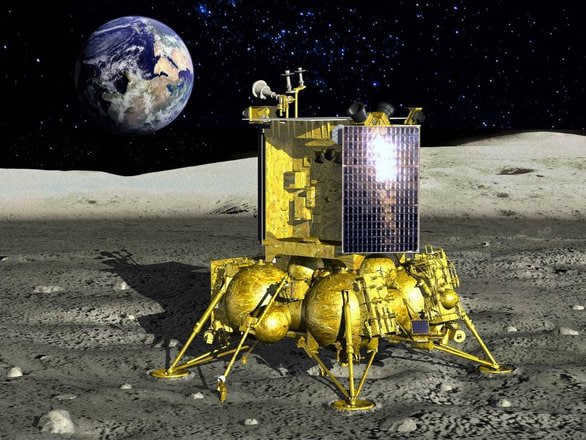
The image above depicts an artist’s representation of the spacecraft “Luna 25” on the surface of Selene. It is important to note that the angular size of the Earth in this picture may not accurately reflect the real conditions on the Moon. Image source: ©Wikimedia Commons
Often, the history of the initial exploration of the Moon is portrayed as a string of uninterrupted triumphs and accomplishments. However, few people are aware that the first moon landing could have ended in disaster if an American astronaut had not intervened and adjusted the automatic landing system at a critical moment. Additionally, despite its impressive technological achievements, the first attempt to study Selene in situ was largely unsuccessful from a scientific standpoint.
What caused the queue to form for the Moon?
It’s true, it may sound unbelievable, but the remarkable achievement of space exploration also turned out to be a disappointment. The landing in the equatorial regions of the Moon led scientists to mistakenly conclude that it was a dry and arid celestial body with minimal amounts of light elements. The data gathered by the Apollo missions (and the limited information provided by the Soviet Luna probes) led to a hypothesis that the Moon was formed when another planet, Teia, collided with the Earth. The intense impact caused the material ejected into space to become so hot that the light elements evaporated.
Developing something similar to this as a foundation is incredibly challenging: in order to transport a ton of cargo to Selene, it is necessary to launch a spacecraft from Earth with a fuel mass of 250 tons. Essentially, this means that we would have to transport air, water, and all other necessary resources to a barren celestial body, requiring monumental efforts in terms of device creation and base maintenance. Without a base, it would be impossible to conduct thorough investigations on another celestial body.
However, our understanding is rather limited. We have gathered information from various space probes, primarily from India, that have used radar to survey the surface of the moon. These probes have detected signals that are indicative of the presence of water ice. It is important to note that radar can only penetrate a few centimeters of lunar dust, so our current knowledge may not accurately represent the true composition of the moon.
There is a new competition emerging in the realm of lunar exploration. The Russian space industry is making efforts to demonstrate its involvement by patenting a multi-launch mission to our planet’s natural satellite. It is clear that this is a substitute for something much larger and more significant.
Furthermore, considering the advancements in scientific discoveries in the 21st century, it is challenging to dismiss the possibility that the interior of the Moon may harbor conditions conducive to the emergence or sustenance of life, whether that be native or brought from Earth. These conditions cannot be ascertained from the Moon’s surface alone. To gain a better understanding, we require actual landings.
It is crucial to recognize that space programs aiming to replicate the moon landings of the 1960s and 1970s will not provide substantial insights. This is precisely what transpired with China’s lunar program. Although China successfully landed two lunar rovers, comparable to the USSR’s achievement, their performance level was notably different. The two moon rovers of the 21st century covered a mere 1.1 kilometers, approximately 50 times less than Lunokhod-1 and Lunokhod-2, the Soviet predecessors from half a century ago.
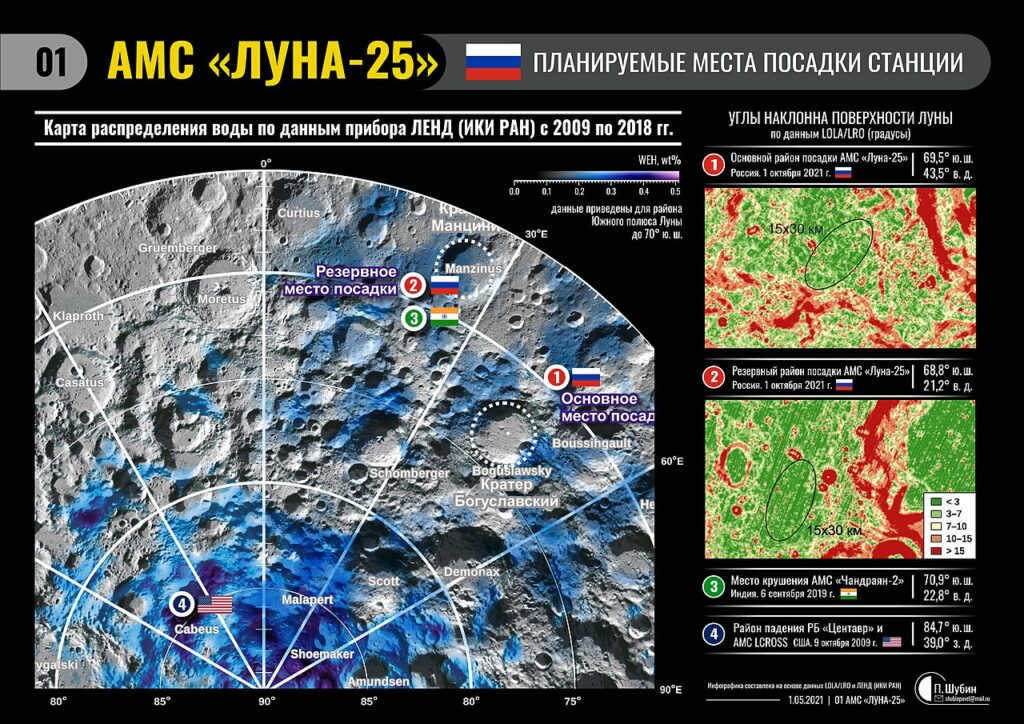
However, the main point is not that: both Chinese lunar rovers were not landed near the poles like their Soviet predecessors. They were not specifically designed for polar conditions, where, for instance, the solar panels need to be positioned differently (on the side of the vehicles instead of on top), which means they could not be easily redirected to promising regions for further study. As a result, the delay in scientific analysis made these missions relatively ineffective despite their high cost. Therefore, they did not contribute anything new to our understanding of water, CO2, and methane. Neither of the two landings brought about a significant change in our knowledge.
We require fundamentally distinct missions. Just like “Luna-25,” or similar to the planned human landing in this decade by NASA, and more importantly, SpaceX.
“Luna-25”: another Soviet mission from the past?
Upon initial inspection, Russia’s most recent lunar mission may appear unimpressive compared to its predecessors. However, it’s worth noting that this mission is not the first to bear the name “Luna-25.” Back in the 1970s, there were plans to send “Lunokhod-3” to the moon as part of the original “Luna-25” mission, a rover capable of traversing long distances. What has changed since then?
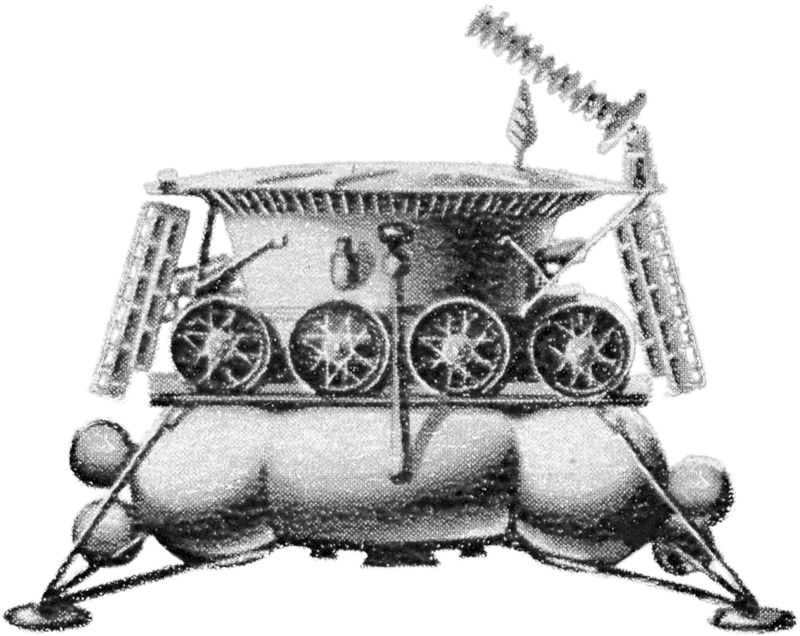
And now, to avoid any confusion, the spacecraft formerly known as “Luna-25” has been renamed “Luna-25A”. It now carries a much smaller payload, consisting of just a dozen scientific instruments weighing a total of 31 kilograms. These instruments are equipped to study the area directly underneath or in close proximity to the landing platform.
The chosen landing site is also quite modest, with coordinates of 69.5450 south latitude and 43.5440 east longitude. To put this into perspective, the city of Murmansk in our hemisphere is located at the 68th degree. So, the claims made by the Russian press about this mission being the first to land at the South Pole of the moon are completely false.
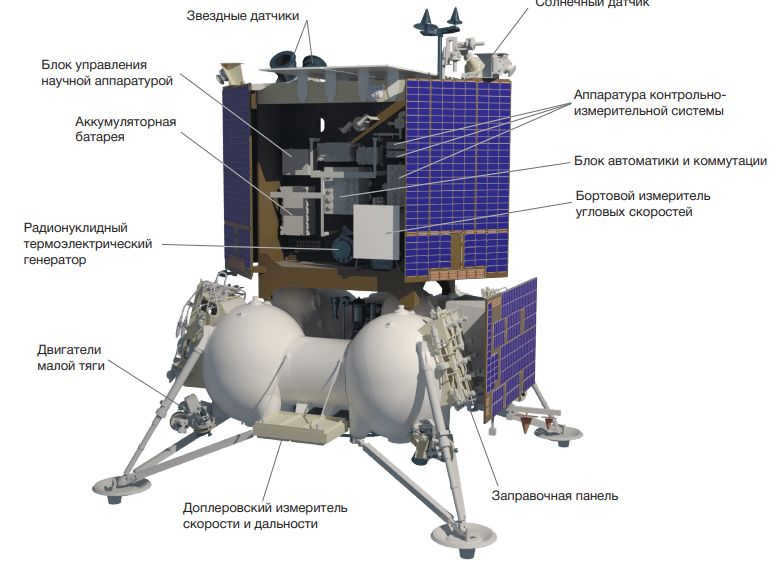
Undertaking a mission to the South Pole is an incredibly intricate task. It presents challenges not only in terms of trajectory, but also in regards to radio communication with Earth and the limited duration of continuous sunlight. The precision of landing on a new celestial body is often less than ideal, allowing for the possibility of significant errors. The designated landing area spans approximately 30 by 15 kilometers.
The relief in the vicinity of the true southern pole of the Moon, which is situated at 90 degrees south latitude, can be described as uneven, to say the least. It is possible to land on the rim of the crater or even inside the crater itself. However, if one happens to land in the deepest part of the crater, there is a significant risk of being deprived of sunlight completely, as this area is shrouded in perpetual shadow. Now let us consider the power aspect of Luna 25: the device is equipped with solar panels on its sides, which provide a power consumption of 100 watts. If the landing location is chosen incorrectly, the device will cease to function.
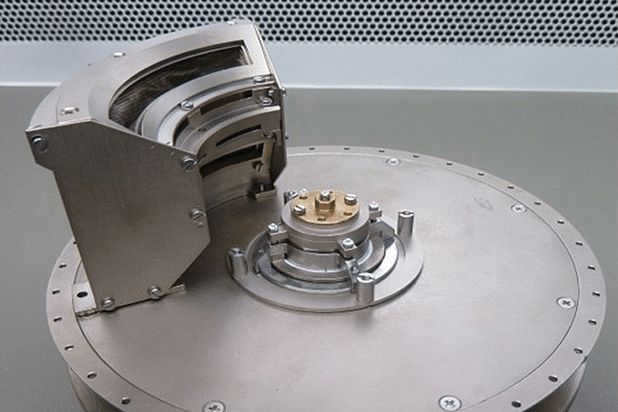
The Russian lunar program has a plan to gradually increase its exploration efforts, particularly in the southern region. For instance, Luna-27 is scheduled to land at a latitude of around 80 degrees south, but this won’t happen until 2028.
Unexpected Water Discovery
Nevertheless, the landing at the 69th degree near the Boguslavsky crater is just as intriguing as the higher latitudes. Initially, it was believed that water could only exist in the permanently shadowed areas of the Moon, primarily in the higher latitudes near crater walls. However, the Russian instrument LEND, which is onboard the NASA probe, unexpectedly revealed that water is actually present in the unshaded areas of the Moon’s high latitudes, similar to permafrost found in Earth’s soil at similar latitudes.
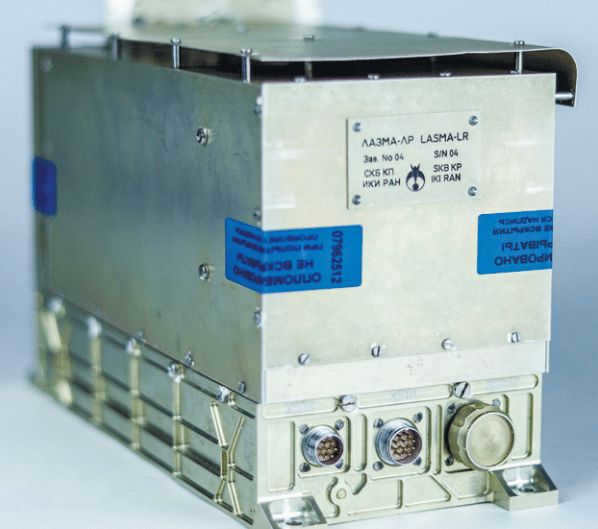
From a scientific standpoint, this was a highly peculiar conclusion for many individuals. The phenomenon of water in the perpetually shadowed region can be explained: when water is brought there by a comet, it will essentially remain as ice for an incredibly long time. However, this is not the case in areas outside of the shadowed regions: even if a comet were to bring ice there, it would evaporate extremely quickly. The notion of icy asteroids skidding also seems implausible: impacts from such celestial bodies create craters that are nearly permanent on the Moon. Furthermore, according to the data from LEND, water has been observed in areas devoid of craters.
It has been discovered that the surface of the Moon contains a substantial amount of carbon – a relatively lightweight element that would not have been able to endure in the composition of Earth’s satellite if it had formed after the collision with Theia. This revelation implies.
For years, Naked Science readers have been aware of the answer to this puzzle: quite simply, the water on the Moon is not from comets (in fact, it is terrestrial in origin). As a result, it is initially distributed relatively evenly across the Moon’s surface, with evaporation occurring primarily in the lower latitudes over millions and billions of years.
However, what adds intrigue to the situation is that many scientists still believe that comets are responsible for the presence of water on the Moon. Therefore, uncovering the mystery of lunar water in “unexpected locations” holds great significance for both Russian and global scientific communities.
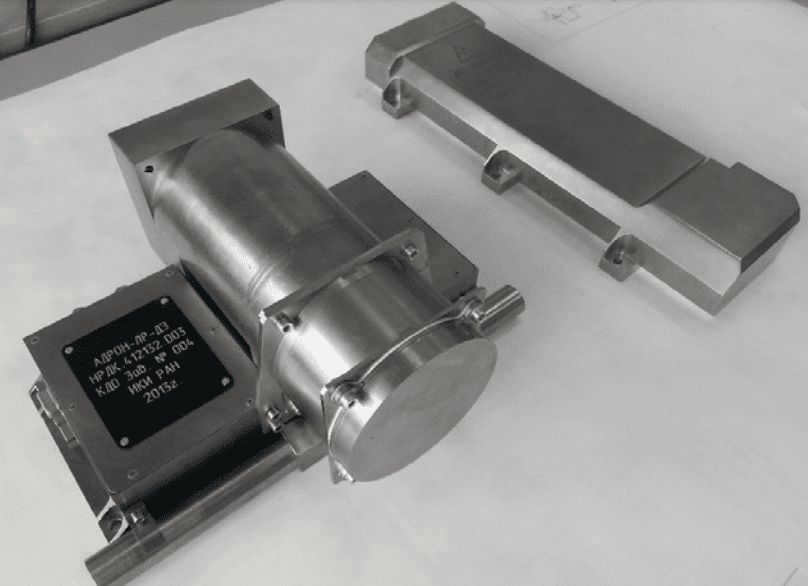
According to the data obtained from LEND in the vicinity of the Moon, the landing area of Luna-25 should contain at least 0.1 percent of water in the upper meter of regolith (ADRON-LR will not go deeper). However, this is just a hypothesis, and in reality, water ice beneath the surface may be distributed in localized areas. It is not clear from orbit whether the lunar “permafrost” is a solid mass or isolated patches, similar to many regions on Earth.
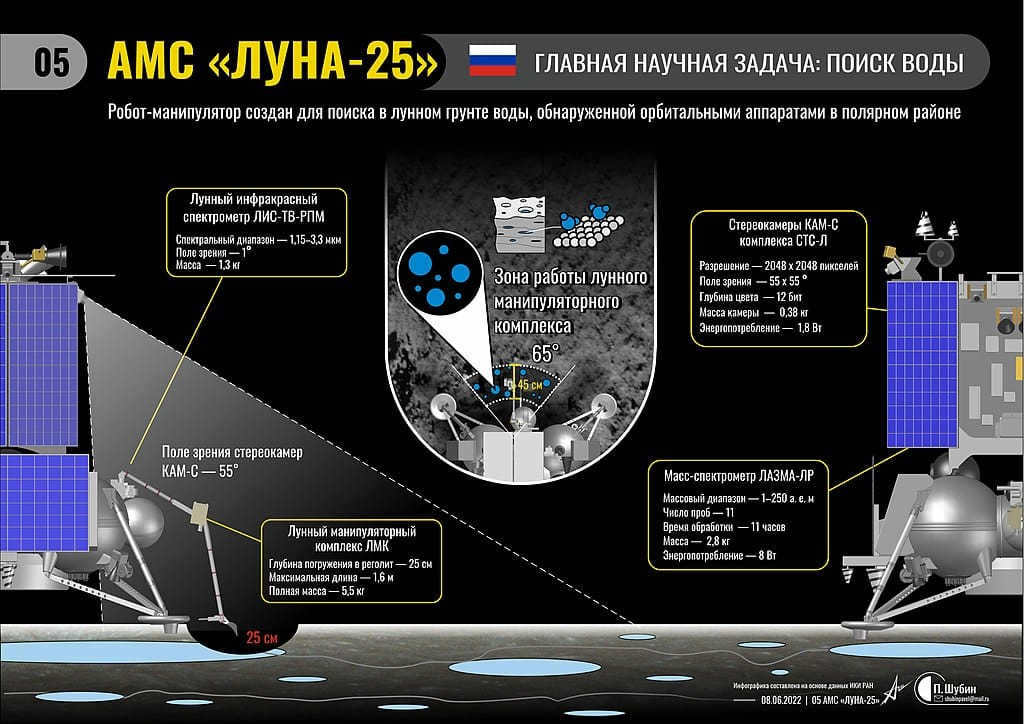
It is worth noting that the landing site of “Luna-25” is located in close proximity to the northern edge of the lunar basin known as the South Pole – Aitken. This particular basin is notable for being the largest and oldest confirmed crater in our entire solar system, boasting dimensions of 2,400 x 2,050 kilometers. The formation of this crater occurred approximately four billion years ago, when a massive asteroid collided with the Moon, resulting in the ejection of numerous ancient “primary” rocks from deep within its interior. It is plausible to assume that a significant number of these rocks still remain on the lunar surface, providing an invaluable opportunity to study them and gain a deeper understanding of the Moon’s formation history.
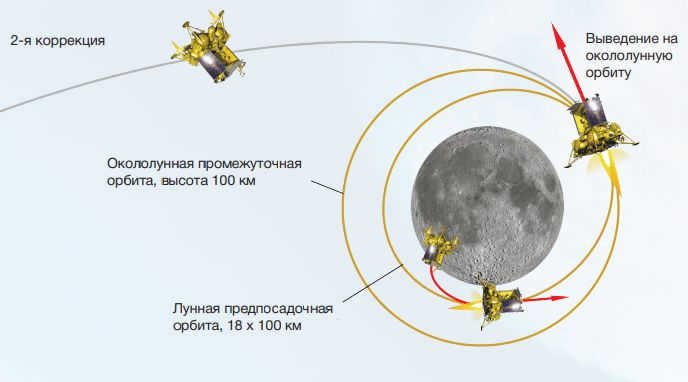
Thus, the design of “Luna-25” is essentially starting from scratch, making the chances of errors quite high. It is not just the landing that the system is likely to handle. Through experiments on Earth using lunar soil simulators, it has become evident that even with a water concentration of 1 percent and lunar temperatures, the soil is as tough as concrete. Digging it up is a formidable task, and even the robotic arm may encounter difficulties.
Other aspects of the mission will also pose significant challenges. Let’s remember: the Chinese lunar rovers faced serious issues during the local night, when temperatures could plummet below minus 170 degrees Celsius. A slight miscalculation in the engineers’ estimation of heating from the radioisotope energy source could result in the batteries becoming too cold, rendering the spacecraft unresponsive come morning.
Recently, NASA’s InSight lander made a groundbreaking discovery on Mars – a lake of unprecedented size. The achievements of robotic explorers in the realm of studying other planets are monumental. However, these machines are unable to provide us with all the answers we seek.
Working on the lunar surface is no walk in the park either. The Russian lunar rover faces a tough challenge during the midday hours when its moving parts can overheat and malfunction due to temperatures reaching a scorching 130 degrees Celsius. It is left with only the morning and evening hours of the four-week lunar day to carry out its tasks. And even during this limited time frame, the success of a lunar year without any breakdowns relies heavily on meticulous calculations.
All of this indicates that the technical obstacles faced in the mission “Luna-25” are just as significant as the scientific ones.
Why so humble?
Our loyal readers may wonder: indeed, reaching the Moon presents its challenges. Numerous advanced nations have attempted and faltered. However, it is undeniably evident that as long as Musk is alive, the United States will achieve a lunar landing in the 2020s. Moreover, they will not settle for a modest landing craft capable of carrying only 30 kilograms of equipment. Instead, they will utilize a colossal Starship that can transport multiple tons of equipment. This impressive vessel will accommodate astronauts and propel them at high speeds across the lunar surface. Additionally, it will house a cutting-edge drilling apparatus, empowering them to delve into unprecedented depths.
Meanwhile, we have plans to transition from Luna-25, which is capable of digging just a few centimeters, to Luna-27, which will have the capability to reach up to a meter in depth by 2028. Predictably, the activities of Luna-27 will be overshadowed by the presence of American astronauts in their advanced lunar rovers. Moreover, the scientific output from Luna-27 will be comparatively lower. The impressive payload capacity of the Starship spacecraft enables astronauts to access the deeper layers of the Moon and retrieve substantial amounts of soil and water ice for analysis back on Earth. Unlike our current apparatuses, which are limited to carrying only 30 kilograms of equipment, the laboratories will have access to multiple tons of lunar samples. Consequently, the results of the analysis will likely yield significantly different findings.

Indeed, there is an element of truth in these statements. Furthermore, it is challenging to disregard an even more offensive possibility, that when examining the lunar samples, evidence of not just ancient, but perhaps even more recent forms of life will be discovered.
It may appear absurd, as the Moon has traditionally been perceived as lifeless. However, there is not much absurdity in this notion. Let us recall that the lunar surface in high latitudes is made up of materials containing noticeable amounts of ice. It is well-known that at depths of several hundred meters, a zone of stable temperatures begins. Furthermore, in certain instances, zones with temperatures above freezing point extend very close to the surface. For instance, observations from lunar orbit have revealed that the floor of a large lunar cave maintains a stable temperature of 17 degrees Celsius. The visible depth of this cave from orbit is 34 meters. The combination of stable high temperatures and the presence of water create conditions in which numerous microorganisms can thrive.
Remember: the Moon consists mainly of material from the Earth. Moreover, not only bacteria but even multicellular organisms can enter a state of suspended animation for tens of thousands of years and then revive and reproduce. The temperature and cosmic radiation inside the debris ejected from the Earth by asteroids were never excessively high: terrestrial organisms can survive there and reach Selene before losing their ability to live.
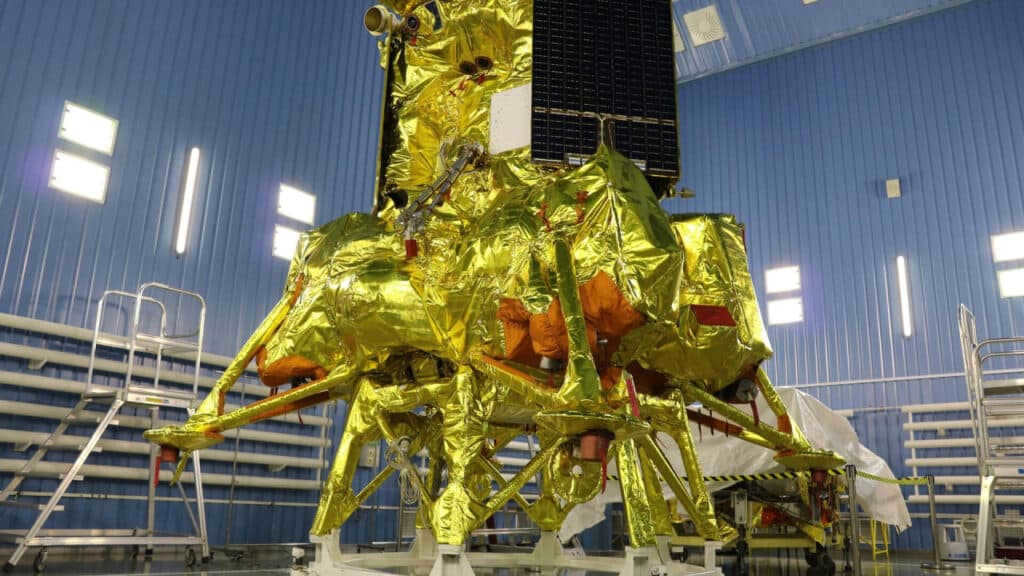
Isn’t it important to consider the temperature and presence of water on the Moon in relation to the possibility of life? Due to the lack of atmosphere, any liquid water on the Moon would quickly evaporate, and the organic remains of any microbes would be destroyed by cosmic radiation, making it difficult to detect any signs of life in lunar conditions.
However, the situation is not entirely straightforward. It is worth noting that in areas with warm soil, near water or dry ice, there is a continuous influx of liquid water from nearby frozen rocks that thaw over time. This process can last for a significant duration without the water boiling off, as a layer of dry soil acts as a barrier.
The planned launch is scheduled for Friday, August 11, at 02:10:57 Moscow time, from the Vostochny Cosmodrome. The live stream will begin at 01:00.
During the evening of August 11, the Luna-25 unmanned spacecraft was successfully deployed from the Vostochny Cosmodrome in the Amur Region. Following a smooth entry into the designated orbit, the spacecraft was propelled further using the Fregat rocket stage, embarking on its long-awaited journey to the Moon. This pivotal mission, eagerly anticipated by space enthusiasts worldwide, marks a significant milestone for Russian cosmonautics. The success of Luna-25 holds immense importance for the future of Russian space exploration. Let us delve into the reasons behind its necessity and the potential impact it holds.
Context
During the Soviet era, a comprehensive research program was established to explore celestial bodies. Initially led by Sergei Korolev’s OKB-1, the projects were later handed over to the Lavochkin NPO. Thanks to the efforts of these organizations, Soviet scientists achieved several groundbreaking milestones, including the successful launch of automated stations to the Moon, Venus, Mars, and Halley’s Comet. The most recent interplanetary mission, which commenced in July 1988, involved the Phobos-1 and Phobos-2 spacecraft. Regrettably, both missions were ultimately unsuccessful, resulting in the loss of the spacecraft.
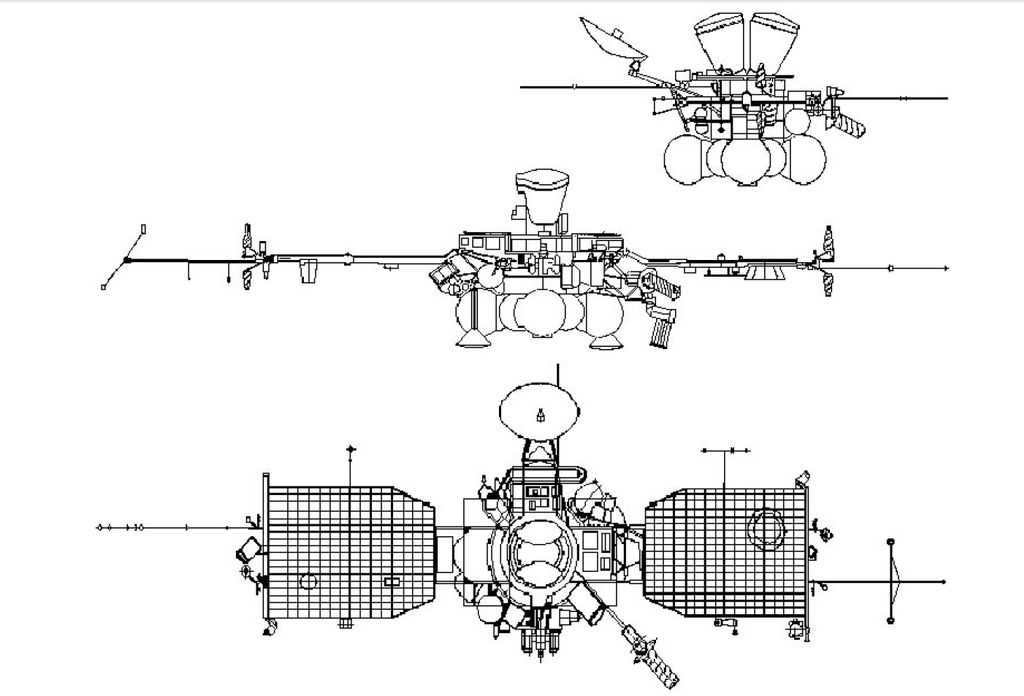

The collapse of the USSR posed obstacles to further exploration. The scientists at Lavochkin NPO attempted to execute the Mars-96 project, which consisted of an orbital block, two small landers, and two penetrators (probes designed to penetrate into the ground). In November 1996, it was launched into Earth’s orbit, but the upper stage failed to place it on an interplanetary trajectory. The Phobos-Grunt station suffered a similar fate when it was launched in November 2011 and also failed to reach Mars.
Despite unsuccessful efforts to surpass previous accomplishments, the work persevered as a country with advanced rockets and spacecraft cannot remain confined to low orbits indefinitely. The rationale behind the development of extraterrestrial infrastructure necessitates the exploration of interplanetary space and the examination of celestial bodies of varying sizes within the solar system in order to identify forthcoming obstacles and potential advantages.
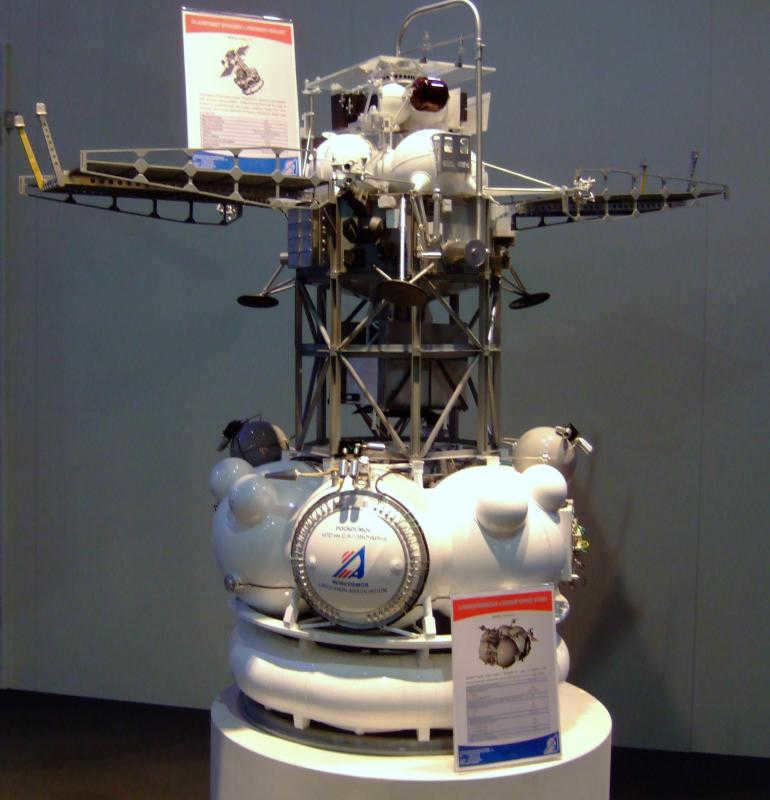
"Phobos-Grunt" was showcased at an air exhibition in 2007 (photo: MKonair). "However, it seems that something is amiss…"
With Mars encountering evident difficulties, experts shifted their focus to the Moon. The most recent Soviet station, Luna-24, successfully touched down there in August 1976, bringing back 170 grams of soil samples from the Sea of Crises. The analysis of these samples yielded a groundbreaking outcome: the presence of water was discovered! The Soviet scientists opted not to publicize their finding, in order to account for the possibility of error, but the scientific precedence was established and later verified.
One issue is the limited duration for which water can remain on the surface of the Moon: due to the absence of atmospheric pressure, it will evaporate when exposed to the sun’s rays and gradually dissipate into space. However, in theory, the water ice delivered by the comet could potentially remain in place for an extended period of time once it reaches the shadow of a crater (referred to as a “cold trap”). As a result, the concept of sending a spacecraft to the Moon’s south pole emerged, as data collected by the American military research vehicle “Clementine” in 1994 suggests the presence of significant deposits of ice weighing approximately 81,000 tons (based on conservative estimates). The ice is not only scientifically intriguing, but it also holds potential as a valuable resource for a research base and as a source of fuel by breaking it down into hydrogen and oxygen.
The Look of Luna-25
The initial information about “Luna-25”, previously known as “Selena” and “Luna-Globe”, was made public in 1997 when Lavochkin NPO’s proposals for solar system exploration were released. The first version of the project resembled “Mars-96” as it planned to send two seismometers, a set of penetrators, and a polar landing station to the Moon. The mission was initially scheduled to begin sometime between 2008 and 2015. However, despite the scientists’ enthusiasm, the government did not rush to allocate funds, instead focusing resources on Phobos-Grunt. Nonetheless, the “Luna-Globe” project persisted and attempted to engage Japanese partners. Initially, the Japanese wanted to send their own apparatus on the same rocket but later settled on manufacturing the penetrators.
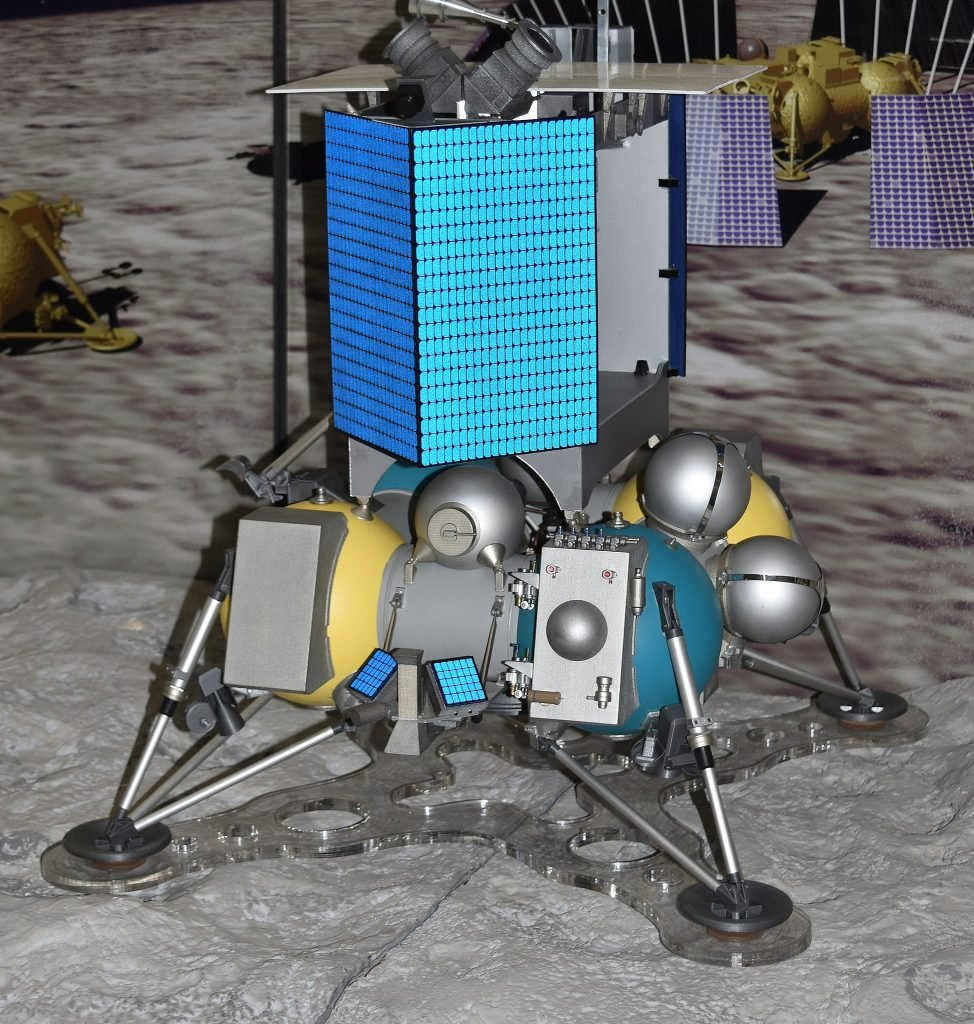
A photo of Luna-Globe in 2015 is shown below (photo: Pline, CC BY-SA 4.0)
Due to various organizational and technical difficulties, the launch date of the station has been postponed multiple times, from 2016 to 2019 and finally to 2021. Additionally, there have been changes in the equipment composition: for instance, the XSAN instrument, developed by Swedish scientists to study the interaction between space plasma and the Moon’s surface, has been transferred to the Chinese.
Prior to the station’s preparation, potential landing sites were identified: the primary site is located north of Boguslavsky Crater, with backup sites located southwest of Manzini Crater and south of Pentland A Crater. In October 2021, it was announced that the assembly of Luna-25 was completed, and in July 2023, after undergoing necessary tests and equipment finalization, it was transported to the Vostochny Cosmodrome.
The flight version of the station is composed of two main components: a landing platform equipped with an engine and a securely sealed instrument container. Within the container, there are several key instruments including the ADRON-LR neutron and gamma-ray spectrometer, which is designed to detect water ice on the lunar surface. Additionally, there is the LMK manipulator, which has the capability to excavate soil and deliver samples to the LASMA-LR laser mass spectrometer. The PML instrument is also housed within the container and is dedicated to studying lunar dust, while the ARIES-L instrument is specifically designed to investigate the rarefied lunar exosphere.
Furthermore, the “Luna-25” is equipped with a sophisticated STS-L system comprised of eight TV cameras. Two of these cameras are positioned at the bottom of the spacecraft, providing a detailed view of the lunar surface. Another four cameras are strategically placed on the sides of the station, allowing for panoramic views of the landing site to be transmitted back to Earth. Lastly, two additional cameras are dedicated to observing the manipulator’s work.
All of the equipment on board the “Luna-25” is powered by solar panels and a radioisotope generator known as RITEG. The RITEG is based on plutonium-238 dioxide and ensures a reliable and sustainable power source for the various instruments and systems on the spacecraft.
What Lies in the Future.
The Luna-25 spacecraft was effectively launched on August 11, at 2:10:57 Moscow time, utilizing a Soyuz-2-1b rocket and entered an Earth orbit for reference. An hour after takeoff, the Fregat upper stage set its course towards the Moon, and the following day, at 4:00 p.m., the spacecraft accomplished a successful trajectory correction. On August 16, it will enter a lunar orbit, and on August 21, it will make an attempt to achieve a gentle landing.
It is worth mentioning that the Russian station is not the only one making its way to the southern pole of the Moon. On July 14th, the Indian spacecraft Chandrayaan-3 was also launched with a small lunar rover called Pragyan. The rover is set to land on August 23rd, so we are essentially witnessing a mini space “race”. If anything were to happen to the Russian station causing a delay in its moon landing, the Indian team would have the opportunity to be the first to reach the destination and establish their historic precedence in exploring the Moon’s southern pole.
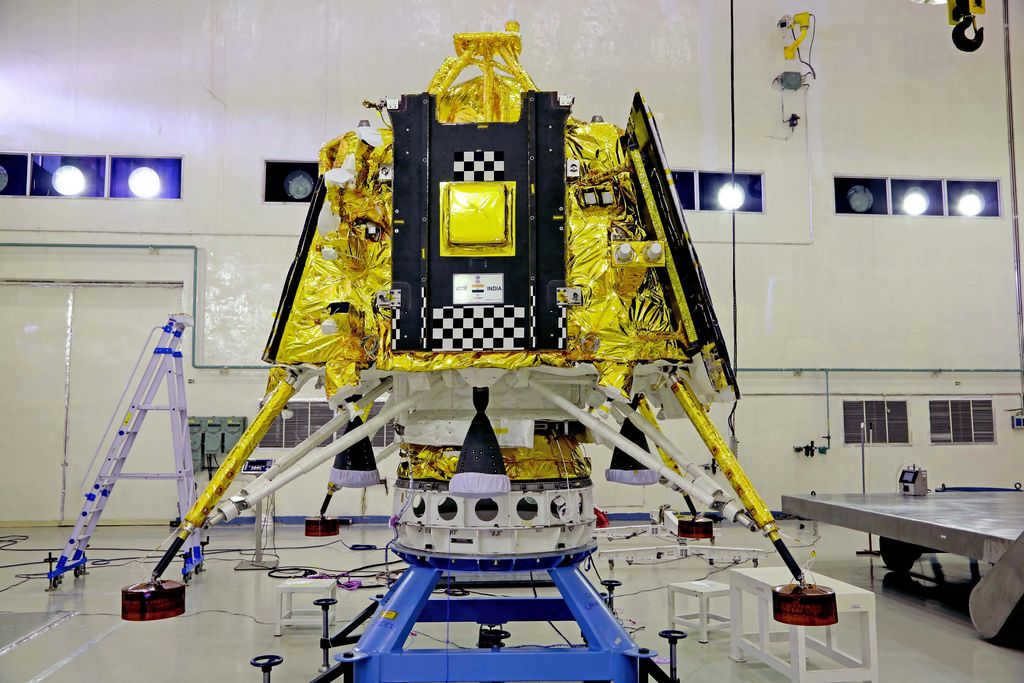
The Indian Space Research Organization has launched the “Chandrayaan-3” landing module, which is seen as a rival to the Russian “Luna-25” mission.

